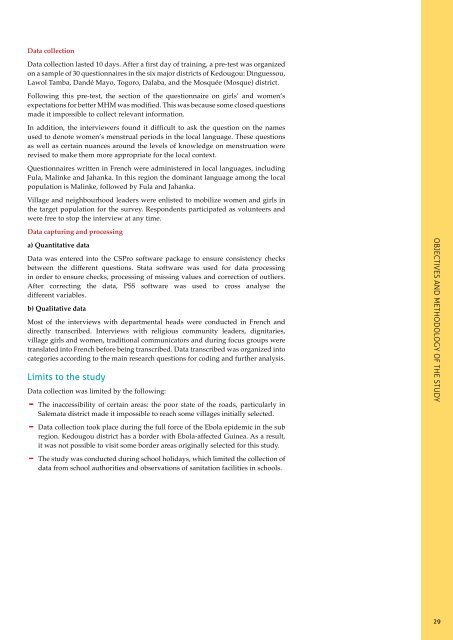1wE4FuZ
1wE4FuZ
1wE4FuZ
You also want an ePaper? Increase the reach of your titles
YUMPU automatically turns print PDFs into web optimized ePapers that Google loves.
Data collectionData collection lasted 10 days. After a first day of training, a pre-test was organizedon a sample of 30 questionnaires in the six major districts of Kedougou: Dinguessou,Lawol Tamba, Dandé Mayo, Togoro, Dalaba, and the Mosquée (Mosque) district.Following this pre-test, the section of the questionnaire on girls’ and women’sexpectations for better MHM was modified. This was because some closed questionsmade it impossible to collect relevant information.In addition, the interviewers found it difficult to ask the question on the namesused to denote women’s menstrual periods in the local language. These questionsas well as certain nuances around the levels of knowledge on menstruation wererevised to make them more appropriate for the local context.Questionnaires written in French were administered in local languages, includingFula, Malinke and Jahanka. In this region the dominant language among the localpopulation is Malinke, followed by Fula and Jahanka.Village and neighbourhood leaders were enlisted to mobilize women and girls inthe target population for the survey. Respondents participated as volunteers andwere free to stop the interview at any time.Data capturing and processinga) Quantitative dataData was entered into the CSPro software package to ensure consistency checksbetween the different questions. Stata software was used for data processingin order to ensure checks, processing of missing values and correction of outliers.After correcting the data, PSS software was used to cross analyse thedifferent variables.b) Qualitative dataMost of the interviews with departmental heads were conducted in French anddirectly transcribed. Interviews with religious community leaders, dignitaries,village girls and women, traditional communicators and during focus groups weretranslated into French before being transcribed. Data transcribed was organized intocategories according to the main research questions for coding and further analysis.Limits to the studyData collection was limited by the following:––The inaccessibility of certain areas: the poor state of the roads, particularly inSalemata district made it impossible to reach some villages initially selected.––Data collection took place during the full force of the Ebola epidemic in the subregion. Kedougou district has a border with Ebola-affected Guinea. As a result,it was not possible to visit some border areas originally selected for this study.– – The study was conducted during school holidays, which limited the collection ofdata from school authorities and observations of sanitation facilities in schools.Objectives and methodology of the study29



